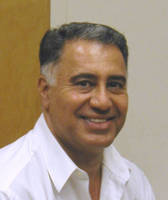Abdul-Mehdi S. Ali, Ph.D.
Senior Research Scientist I

Analytical Chemistry Laboratory Manager
- Education:
- Ph.D., University of Arizona, 1989
- Email:
- mehdiali@unm.edu
- Phone:
- 505-277-1637
- Office:
- Northrop Hall, Rm. 213
Research and Academic Interests:
One of my main responsibilities is Analytical Chemistry Laboratory Management, which includes operation, maintenance, and trouble shooting of highly specialized computer controlled instruments. Responsible for data processing, validation, and quality assurance and quality control measures (QA/QC). Implementing approved analytical protocols, laboratory Quality Assurance Plan (QAP), and Standard Operating Procedures (SOP's) for samples analyses. Working with and instructing students and other laboratory users on the proper use and operation of instruments and sample processing and analysis. Experience in laboratory accreditation and ISO Guidelines (A2LA, American Association for Laboratory Accreditation and NELAC, National Environmental Laboratory Accreditation Conference).
My research interest is in the Analytical Chemistry and Environmental studies. The analytical chemistry studies include analytical methods development and /or modification for chemical analysis (Performance Based Methods). The focus of these studies is to develop cost effective, accurate, fast, and low chemical waste generating analytical methods, such as determination of total sulfur in solids using Ion Chromatography (Liquid chromatography), carbon and chloride analysis via ICP as compared to other standard methods, open vessel microwave digestion, organic matter determination by modified loss of ignition, impact of various acid pre - treatment on organic carbon analysis of soil, alternative catalyst used in plant Kjeldahl methods, and modified hexavalent chromium determination by colorimetry.
The environmental studies included soil, and water bio-chemical remediation such as hexavalent chromium bioremediation in highly contaminated soils and arsenic phytoremediation from contaminated water sources. Other studies involved the use of biofiltration and recycling (minimum exchange) of effluent and wastewater for water quality improvement to meet regulatory standards in aquaculture. Other studies included monitoring the fate, transport, transformations, and mobility of elements through soil profile into the ground water from biosolids amended soils.
Recent Publications:
Artiola, J. F. and A. S. Ali. Determination of Total Sulfur in Soil and Plant Samples Using Sodium Bicarbonate/Silver Oxide, Dry Ashing and Ion Chromatography. Communications in Soil Science and Plant Analysis, 1990, 21: 941-949.
Ali, A.S. and J.L. Stroehlein. Reactions of Urea Phosphate in Calcareous and Alkaline Soils: I. Ammonia Volatilization. Communications in Soil Science and Plant Analysis, 1991, 22: 1243-1256.
Ali, A.S. and J.L. Stroehlein. Reactions of Urea Phosphate in Calcareous and Alkaline Soils: II. Effect on Soil Sodium and Salinity. Communications in Soil Science and Plant Analysis, 1991, 22: 1257-1268.
Assadian, N.W., L.C. Esparza, L.B. Fenn, A.S. Ali, S. Miyamoto, U.V. Figueroa, and A.W. Warrick 1998. Spatial Variability of Heavy Metals in Irrigated Alfalfa Fields in the Upper Rio Grande River Basin. Agricultural Water Management Journal, 36: 141-156.
Assadian, N.W., L.B. Fenn, M. Flores-Ortiz, and A.S. Ali, 1999. Spatial Variability of Solutes in a Pecan Orchard Surface-Irrigated with Untreated Effluents in the Upper Rio Grande River Basin. Agricultural Water Management Journal, 42: 143 - 156.
Bader, J.L., G. Gonzalez, P.C. Goodel, A.S. Ali, and S.D. Pillai, 1999. Chromium-Resistant Bacterial Populations from A site Heavily Contaminated with Hexavalent Chromium. Water, Air, and Soil Pollution Journal, 109: 263-276.
Bader, J.L., G. Gonzalez, P.C. Goodel, A.S. Ali, and S.D. Pillai, 1999. Aerobic Reduction of Hexavalent Chromium in Soil by Indigenous Microorganisms. Bioremediation Journal, 3 (3): 201-211.
